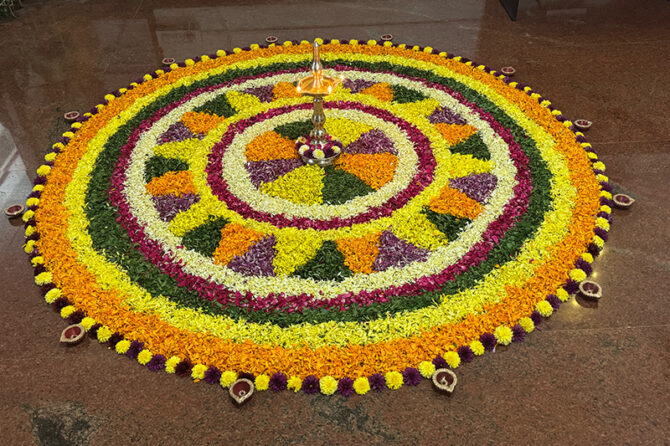
As in previous years, I saw an sudden outpouring of excitement and happiness in anticipation of Deepawali in my own household. My wife, Shailashri, motivated our children and the entire staff in my office to make a lovely Rangoli together. As an avid observer and lifelong learner, for the first time, I decided to step back and appreciate the profound learning opportunities that lie behind making a Rangoli, where the act of making something so simple teaches us so much on the principles of leadership.
1. The Circle of Colours: A Canvas for Creativity
In essence, Rangoli is creativity in action. In Rangoli, the artist starts with an uncoloured floor, just as a leader starts with an unshaped vision. Also, in Rangoli, the artist starts with an idea – perhaps from memory, perhaps from imagination – and then converts it into a coloured reality, much like the manner in which a leader converts his ideas into an actioned reality.
In an Indian household, Rangoli represents an invitation to positivity, prosperity, and God’s grace, particularly that of Goddess Lakshmi’s. It also teaches us that creativity, in its true form, is for a bigger cause – it’s an enabler, motivator, and an instrument for bringing harmony in life. Leadership should also mean making something new out of something significant.
As Rabindranath Tagore aptly stated, “The highest education is that which gives us not only information but makes our life in harmony with all existence.” Rangoli making, in a way, is education in harmony – where art is in perfect harmony with life!
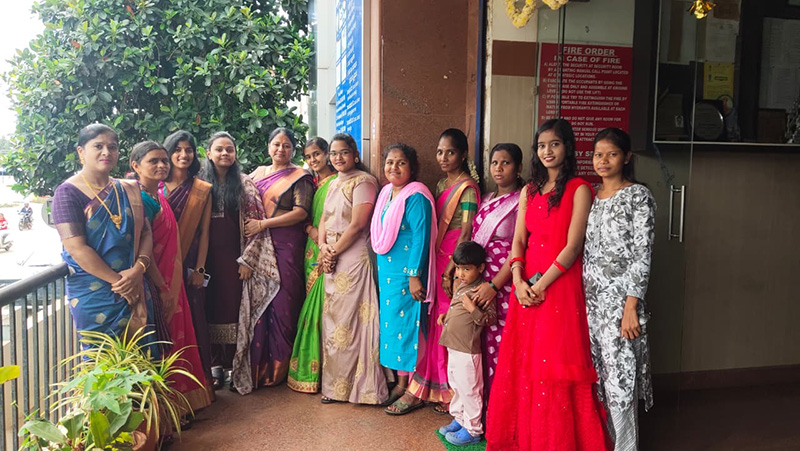
2. Teaming up on the Doorstep: The Role of the Family
In homes like mine, no Rangoli is an individual’s effort alone. The design conceptualized by my wife, coloured in by the kids, with contributions from the office and domestic staff on ideas that brought smiles to their faces—is team spirit in its purest form.
And that is the nature of excellent organizations – a collaboration between different individuals for a single objective. Each individual lends his/her Strengths – one with Creativity, another with Precision, another with Enthusiasm. The beauty is in Participation, not in Flair.
Leadership is the art of making that collective energy possible. As Ratan Tata so aptly said, “If you want to walk fast, walk alone. But if you want to walk far, walk together.” Rangoli is an excellent reminder that the key to true success is walking – and working – together.
3. The Blueprint: Vision And Planning Prior To Execution
Rangoli is an art that begins with a drawing – a rough sketch on the floor, an idea in one’s mind, a notion for proportion and symmetry before the pouring of colours begins. All these amount to strategic thinking in action.
Leaders also need to visualize before acting on their plans. They need to visualize the big picture while considering even the minute details. An improperly planned Rangoli creates imbalance; similarly, un planned leadership creates chaos.
As Dr. A.P.J. Abdul Kalam reminded us, “Dream, dream, dream. Dreams transform into thoughts and thoughts result in action.” Rangoli starts with a dream, and with action, it turns into a reality.
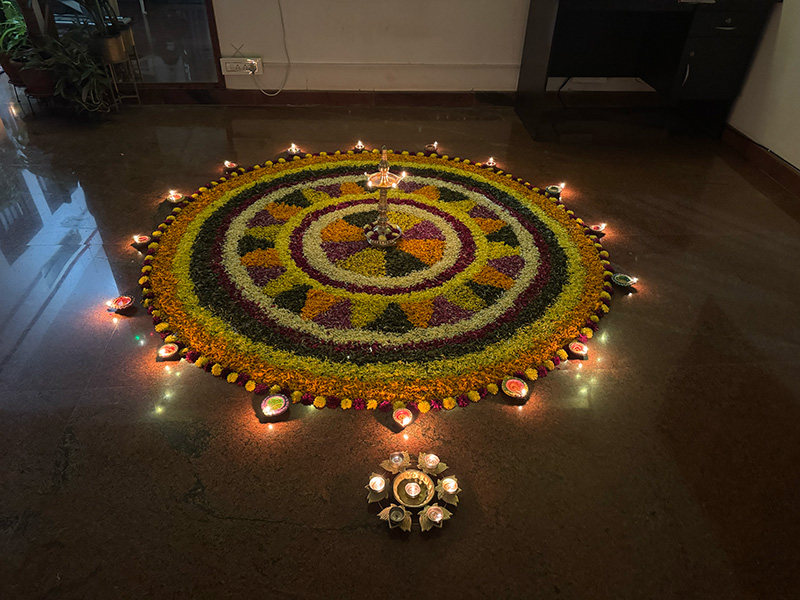
4. Imperfect Handling: Grace Under Pressure
When their first attempt with a design resulted in a smear, there were chuckles – no frustration in sight. The weakness was simply incorporated into another form, sometimes improving it in the pattern itself. That step provided a critical management lesson in resilience and adaptability.
In the corporate or institutional world, mistakes are inevitable. But strong teams, like good artists, don’t start over in despair — they adapt, improvise, and move forward. The capacity to turn errors into opportunities defines great leaders.
Nelson Mandela once said, “Do not judge me by my success, judge me by how many times I fell down and got back up again.” An imperfect Rangoli design can also be lovely – so can an imperfect team if it is able to rise back up with dignity.
5. Diversity of Colours: Inclusion in Action
A Rangoli’s magic lies in its diversity of colours. Each hue — vibrant red, calm blue, joyful yellow, or sacred white — plays its part. Remove one, and the design feels incomplete. Similarly, organizations thrive when they embrace diverse minds and talents.
Inclusive leadership means that no matter how small the voices might be, they need to be counted in the big picture. As Howard Schultz, ex-CEO Starbucks Corp., stated, “When you’re surrounded by people who share a passionate commitment around a common purpose, anything is possible.”
Rangoli shows us that unity is not sameness — it’s harmony among differences.
6. Patience and Precision: The Discipline of Excellence
Observing the construction of the Rangoli, I realized that the hands that were engaged in this work were so steady and patient. Each morsel of colouring was placed so carefully. There was no need for haste; only concentration.
“Patience is patience in greatness,” exactly like the quality of leadership required in “leadership is patience in action,”reflecting character in action in its truest form. “The Bhagavad Gita states: ‘Yogaḥ karmasu kauśalam’ – perfection in action is yoga,” and so is “Drawing Rangoli art is meditation in action – action is leadership, so is leadership in action.”
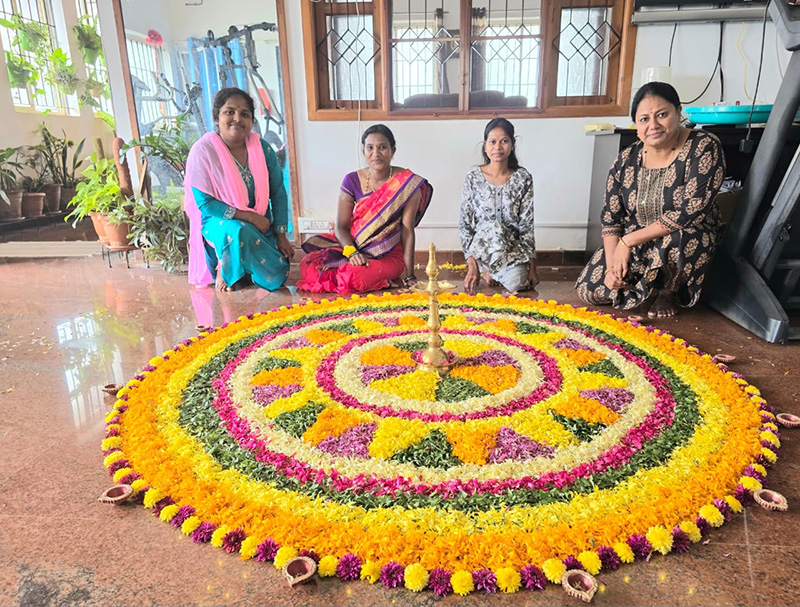
7. Passing the Torch: Mentorship And Legacy
In many homes, seniors teach the young ones on how to make Rangoli art, with instructions on symbols to use, stories behind these symbols, and so on. That is mentorship in its purest form, where experienced teach novices in the ways of art and life.
Organizations grow well if their seniors also act as teachers to the next generation, imparting their knowledge rather than hoarding it. Swami Vivekananda’s words aptly state: “We are what our thoughts have made us; so take care what you think. Words are secondary. Thoughts live; they travel far.”
Thoughts and values in the mentorship of Rangoli-making are passed from generation to generation.
8. Transient but Eternal: The Art Of Letting Go
By the next morning, the Rangoli is likely to be cleaned away, worn out by feet or by time. Still, no one mourns it. The happiness is in the doing, not in the lasting.
But this impermanency also holds secrets to detachment and humility in leadership. Leaders need to understand that they build, appreciate, and let it go, so that new thoughts, new ideas, and new leaders emerge. “Nothing is forever except change itself,” goes a Buddhist aphorism. The Rangoli reminds us that leadership is not about ownership; it’s about creating something that inspires others long after you’ve moved on.
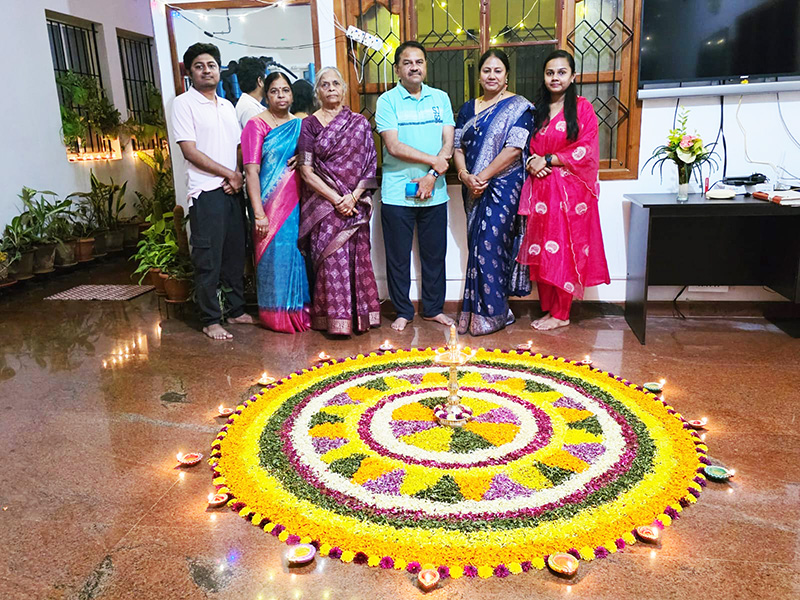
Final thoughts: The Leadership Pattern Beneath the Colours
This Deepawali, watching the children, Shailashri, and the team come together in celebration with the colours, I realized that the Rangoli is more than aesthetics – it is a philosophy that stands for creativity with a vision, teamwork with trust, diversity with harmony, and leadership with humility. In every curve, in every colour, is a lesson: leading is more than reaching success – it is encouraging collective happiness. Therefore, the next time you witness a Rangoli being made at someone’s entrance, do pause for a moment. Look beyond the design that is being created in Rangoli. There’s more to it – the story behind the formation of magnificent teams in homes and in an office. Since, ultimately, Rangoli art and leadership also have one truth in common—that is, the act of creation is as significant as the creation itself.
Dr. Prahlada N.B
MBBS (JJMMC), MS (PGIMER, Chandigarh).
MBA in Healthcare & Hospital Management (BITS, Pilani),
Postgraduate Certificate in Technology Leadership and Innovation (MIT, USA)
Executive Programme in Strategic Management (IIM, Lucknow)
Senior Management Programme in Healthcare Management (IIM, Kozhikode)
Advanced Certificate in AI for Digital Health and Imaging Program (IISc, Bengaluru).
Senior Professor and former Head,
Department of ENT-Head & Neck Surgery, Skull Base Surgery, Cochlear Implant Surgery.
Basaveshwara Medical College & Hospital, Chitradurga, Karnataka, India.
My Vision: I don’t want to be a genius. I want to be a person with a bundle of experience.
My Mission: Help others achieve their life’s objectives in my presence or absence!
My Values: Creating value for others.
Leave a reply















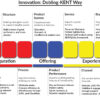
*Rangoli Reflections: A Symphony of Leadership* 🎨👏
Your blog post, "Rangoli and the Art of Leadership," is a masterpiece, Dr. Prahlada N.B Sir 🙏. Like a beautifully crafted Rangoli, your words weave together creativity, leadership, and life lessons in a mesmerizing pattern 🌈💫.
The way you liken Rangoli to leadership is striking 💡. Just as a Rangoli begins with a vision, leaders must envision and bring their ideas to life 🌟. The intricate designs and colors represent the diversity and harmony that leaders must strive for 🌈👥.
Your anecdotes, like the one about incorporating imperfections into the design, are invaluable 💯. They remind us that adaptability and resilience are essential in both art and leadership 💪.
The Rangoli's transient nature 🕰️ is a poignant reminder of the importance of letting go and embracing change 🌱. Your writing is a testament to the power of creativity and leadership 🌈💫.
*A Symphony of Insights* 🎶
– *Creativity is the spark that ignites the flame of innovation* 🔥
– *Teamwork is the harmony that creates a masterpiece* 🎨
– *Adaptability is the key to turning imperfections into opportunities* 🔑
– *Diversity is the palette that adds color to our lives* 🌈
Thank you for sharing your wisdom and creativity with us, Dr. Prahlada N.B Sir 🙏. Your words will undoubtedly inspire and motivate many 🌟. Keep creating and sharing your masterpiece with the world 🌈💕.
ReplyBeautifully narrative and so true . Blending the art of Rangoli to the craft of leadership is so wonderfully matched. Teamwork matters and the philosophy of taking the team together is so important in healthcare and across. Great read for me . Enjoyed every bit . Congratulations and best wishes
Reply